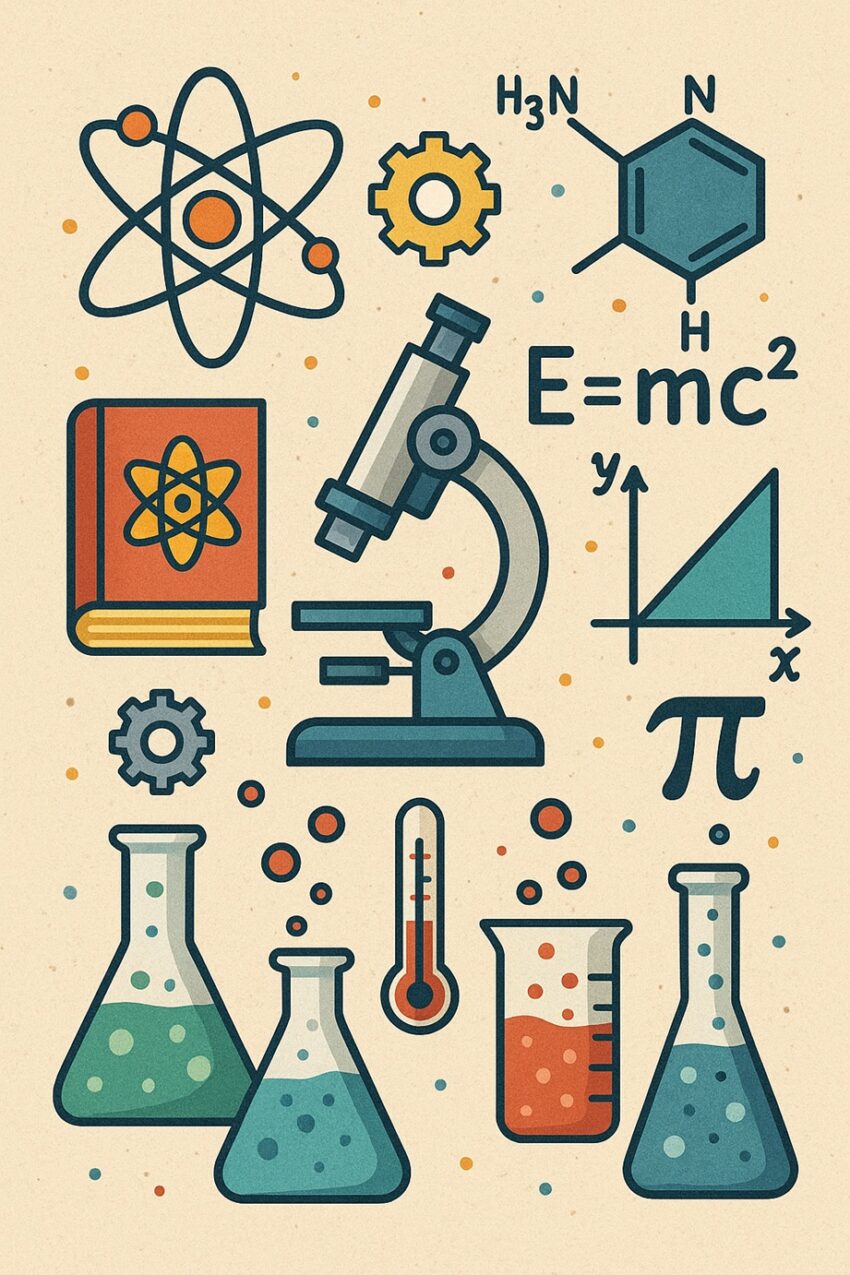This post presents a curated list of 100 foundational, enabling, and breakthrough technologies that have shaped the modern innovation ecosystem across computing, biology, energy, materials, and communication.
These are not end-user products, but core technologies—scientific or engineering breakthroughs—that serve as the infrastructure behind applied innovation.
Why This List?
We selected these 100 technologies based on the following criteria:
Foundational role – They enabled entire categories of modern inventions or industries. Cross-domain impact – Most apply across multiple sectors or scientific fields. Enduring or emerging significance – They’ve shaped the past, or are defining the future. Scientific credibility – All are based on rigorously proven engineering or scientific methods.
COMPUTING & INFORMATION TECHNOLOGY
- Transistor (1947, Electronics) – Replaced vacuum tubes; enabled miniaturization and modern computing.
- Integrated Circuit (IC) (1958, Electronics) – Enabled compact, reliable, and scalable computing hardware.
- Microprocessor (1971, Computing) – Combined CPU functions onto a single chip; foundational to PCs.
- Floating Gate MOSFET (1967, Computing) – Core of flash memory; enabled portable digital storage.
- Random Access Memory (RAM) (1950s, Computing) – Allowed fast, temporary data access in computing systems.
- Hard Disk Drive (HDD) (1956, Data Storage) – Enabled mass digital storage for enterprise and personal computing.
- Solid-State Drive (SSD) (1991, Storage) – Flash-based high-speed storage replacing mechanical HDDs.
- Operating System (e.g., Unix) (1969, Software) – Provided foundational software control and abstraction.
- Relational Database (1970, Information Systems) – Enabled structured data storage, retrieval, and management.
- Public-Key Cryptography (1976, Cybersecurity) – Made secure digital communication and transactions possible.
- Internet Protocol Suite (TCP/IP) (1970s, Networking) – Standardized global digital communications.
- World Wide Web (1989, Web Infrastructure) – Hypertext-based information system; enabled digital economies.
- Cloud Computing (2006, Computing Infrastructure) – Allowed scalable, on-demand computing resources.
- Virtualization (1990s, Systems Architecture) – Abstracted hardware; enabled cloud and container computing.
- Machine Learning Algorithms (1980s–2000s, AI) – Core for pattern recognition and intelligent automation.
- Quantum Computing Principles (1980s, Quantum Physics) – Laid the groundwork for a new computing paradigm.
- Neural Networks (1950s–1980s, AI/ML) – Inspired deep learning models used in modern AI.
- Blockchain Protocols (2008, Distributed Systems) – Enabled decentralized, trustless transactions and data integrity.
- GPU Acceleration (GPGPU) (2000s, Computing) – Repurposed graphics processors for parallel computation.
- Edge Computing (2010s, IoT/AI) – Brought data processing closer to devices; reduced latency.
ENERGY & POWER SYSTEMS
- Photovoltaic Cell (1954, Renewable Energy) – Converted sunlight into electricity; core of solar panels.
- Lithium-Ion Battery (1991, Energy Storage) – Enabled portable electronics and electric vehicles.
- Fuel Cell (1839, Clean Energy) – Converts chemical energy into electricity; key for hydrogen economy.
- Supercapacitors (1957, Energy Storage) – Provide rapid energy discharge; complement batteries.
- Solid-State Battery (2010s, Energy Storage) – Promises safer, denser energy storage.
- Power Electronics (IGBTs) (1980s, Electrical Engineering) – Enabled efficient control of electric power.
- Smart Grid Technologies (2000s, Power Systems) – Enabled dynamic electricity management and distribution.
- Nuclear Fission Reactor (1942, Energy) – Produced large-scale continuous power for grids and subs.
- High-Voltage DC Transmission (HVDC) (1930s–1950s, Energy Transmission) – Enabled efficient long-distance electricity delivery.
- Perovskite Solar Cells (2010s, Photovoltaics) – Emerging class with high efficiency and low cost potential.
BIOLOGY, MEDICINE & GENETICS
- DNA Double Helix Discovery (1953, Molecular Biology) – Basis for genetic understanding and biotechnology.
- Polymerase Chain Reaction (PCR) (1983, Molecular Biology) – Enabled rapid DNA amplification; core for diagnostics.
- Monoclonal Antibodies (1975, Immunology) – Enabled targeted treatments, especially in oncology.
- CRISPR-Cas9 (2012, Genetic Engineering) – Enabled precise, programmable gene editing.
- Recombinant DNA Technology (1973, Biotechnology) – Foundation of genetic engineering and GMOs.
- Human Genome Project (1990–2003, Genomics) – Mapped human DNA; opened new fields in medicine.
- Bioinformatics Algorithms (1990s, Computational Biology) – Allowed analysis of genomic and proteomic data.
- mRNA Delivery Systems (2010s, Biotech) – Enabled rapid development of next-gen vaccines.
- Lab-on-a-Chip (1990s, Biomedical Engineering) – Miniaturized laboratory functions for diagnostics.
- 3D Bioprinting (2010s, Biomedical Devices) – Enables fabrication of tissues and organ models.
MATERIALS & MANUFACTURING
- Carbon Nanotubes (1991, Nanotechnology) – Strong, conductive materials for electronics and composites.
- Graphene (2004, Nanomaterials) – Ultra-thin, strong, conductive; opens applications in electronics, energy.
- Optical Fibers (1966, Materials/Telecom) – Enabled high-speed, long-distance communications.
- Metamaterials (2000s, Physics) – Artificial materials with unusual electromagnetic properties.
- Shape Memory Alloys (1960s, Smart Materials) – Used in robotics, aerospace, medical devices.
- Aerogels (1931, Advanced Materials) – Extremely low-density insulators used in space and energy tech.
- Additive Manufacturing (3D Printing) (1980s, Manufacturing) – Shifted design from subtractive to generative.
- Photolithography (1960s, Semiconductors) – Key in microfabrication of integrated circuits.
- Self-Healing Materials (2000s, Smart Materials) – Can autonomously repair damage; useful in infrastructure.
- Atomic Layer Deposition (ALD) (1970s, Nanofabrication) – Enables atomic-scale coating for semiconductors.

COMMUNICATION & SIGNAL PROCESSING
- Shannon Information Theory (1948, Communications) – Foundation of digital communication and data compression.
- Modulation Techniques (AM, FM, QAM) (1920s–1970s, Communications) – Enabled efficient signal transmission.
- Microwave Technology (1940s, Telecom) – Enabled radar and point-to-point data transmission.
- Satellite Communication (1962, Telecommunications) – Enabled global broadcasting and navigation.
- Fiber Optic Communication (1970s, Data Transmission) – High-bandwidth, low-loss medium for internet backbones.
- Multiple Access Protocols (TDMA, CDMA, OFDMA) (1980s–1990s, Wireless Tech) – Enabled multiple users to share spectrum.
- Semiconductor Laser (Laser Diode) (1962, Photonics) – Core to fiber optic networks and many consumer devices.
- Digital Signal Processing (DSP) (1960s–1980s, Electronics) – Enabled audio, video, radar, and biomedical applications.
- Millimeter-Wave Technology (2010s, Wireless) – Essential for 5G and high-frequency communications.
- MIMO (Multiple Input Multiple Output) (2000s, Wireless Comms) – Boosted capacity and reliability of wireless systems.
ROBOTICS, AUTOMATION & CONTROL
- PID Control Theory (1920s, Automation) – Core for controlling mechanical and electronic systems.
- Industrial Robots (1960s, Manufacturing) – Enabled automated assembly and precision tasks.
- LIDAR (1960s, Sensing) – Used for 3D scanning, autonomous navigation, and mapping.
- SLAM Algorithms (1990s–2000s, Robotics) – Simultaneous localization and mapping for autonomous systems.
- MEMS Sensors (1980s, Embedded Systems) – Enabled miniaturized motion and environmental sensing.
- Machine Vision (1980s, Automation) – Allowed machines to interpret visual data for QA, navigation.
- Embedded Systems (1970s, Electronics) – Specialized computing within other systems/devices.
- Actuators (Piezoelectric, Hydraulic, etc.) (Various, Mechatronics) – Convert signals into mechanical motion.
- Robotic Process Automation (RPA) (2010s, Enterprise Automation) – Automates routine digital tasks.
- Human-Machine Interfaces (HMI) (1980s–1990s, UI/UX) – Enabled intuitive interaction with machines.
EARTH, SPACE, ENVIRONMENTAL & SENSOR TECHNOLOGIES
- Global Positioning System (GPS) (1978–1995, Satellite Tech) – Enabled precise location and navigation.
- Remote Sensing Satellites (1970s, Earth Observation) – Enabled environmental and agricultural monitoring.
- Environmental Sensors (Air/Water/Soil) (1990s–2000s, Sustainability) – Enabled smart monitoring systems.
- Ion Mobility Spectrometry (1970s, Analytical Chemistry) – Portable chemical detection (e.g., explosives, toxins).
- Seismic Imaging & Tomography (1980s, Geoscience) – Enabled deep-earth imaging for oil, minerals, and tectonics.
- Mass Spectrometry (1910s–1940s, Analytical Chemistry) – Key to analyzing molecular structures.
- NMR (Nuclear Magnetic Resonance) (1946, Chemistry/Biology) – Enabled molecular structure determination.
- Electron Microscopy (1930s, Imaging) – Enabled nanoscale visualization of materials and biological structures.
- Cleanroom Technology (1960s, Manufacturing/Research) – Enabled fabrication of semiconductors and biotech.
- Autonomous Drones (2000s, Aerial Robotics) – Enabled automated aerial imaging, delivery, and inspection.
HUMAN INTERACTION, UX & ENABLING SOFTWARE
- Graphical User Interface (GUI) (1973, Human-Computer Interaction) – Enabled user-friendly computing.
- Speech Recognition Engines (1990s–2010s, HCI/AI) – Enabled voice interfaces and accessibility tools.
- Natural Language Processing (NLP) (1950s–2020s, AI) – Enabled machine understanding of human language.
- Compiler Technology (1950s, Programming) – Translated human-readable code into machine instructions.
- Version Control Systems (1980s–2000s, Software Dev) – Enabled collaborative software development.
- Containerization (e.g., Docker) (2013, Software Infrastructure) – Enabled portable, isolated software environments.
- Open Source Licensing (1980s, Software/IP) – Enabled community-driven innovation.
- Data Compression Algorithms (LZW, JPEG, MP3) (1980s–1990s, Digital Media) – Enabled efficient storage/transmission.
- Augmented Reality Frameworks (2010s, UX/Spatial Computing) – Enabled real-time overlays for digital-physical interaction.
- Digital Twin Technology (2000s, Simulation) – Enabled virtual modeling of physical systems.
CROSS-DOMAIN OR SYSTEMIC FOUNDATIONS
- Finite Element Analysis (FEA) (1950s, Engineering Simulation) – Enabled modeling of stress, heat, and deformation.
- Bayesian Inference Systems (1700s–1990s, Statistics/AI) – Enabled probabilistic modeling and decision-making.
- Monte Carlo Simulations (1940s, Computational Science) – Used for probabilistic modeling in many domains.
- Control Theory (1940s–1960s, Systems Engineering) – Core for automation, robotics, and aerospace systems.
- Systems Biology (2000s, Life Sciences) – Modeled complex interactions in biological systems.
- Geographic Information Systems (GIS) (1960s, Mapping) – Enabled spatial data analysis and visualization.
- Digital Ledger Technology (2008, Finance/Data Integrity) – Enabled tamper-proof, decentralized records.
- Standards and Protocols (IEEE, ISO, etc.) (Ongoing, Meta-Innovation) – Enabled interoperability and safety.
- Formal Verification Tools (1990s–2000s, Software Assurance) – Proved correctness of algorithms in critical systems.
- Multi-Agent Systems (1990s–2020s, AI & Simulation) – Modeled interactions between autonomous decision-makers.
Use This As a Reference
This list is meant to serve as a reference point for innovators, educators, strategists, and investors seeking to understand the technologies that truly matter at the foundational level.
You are welcome to cite or link to this page in your own work, presentations, or reports.
This blog post was written with the assistance of ChatGPT, based on ideas and insights from Edgar Khachatryan.
